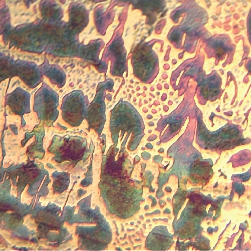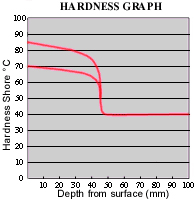The inherent advantage of the steel and chill rolls respectively made way for something in between where one can get higher hardness and toughness with better roll-strength. Thus, here, the conventional composite rolls are produced by a special double-poured casting method in which two independent zones having a shell of highly alloyed iron & another softer grey iron core. The hardest type of roll is one in which cementite is contained in a martensitic matrix. In newly installed up-to-date mills, high speed and heavy reduction rolling is performed and the rolls of topmost quality combining high strength with good wear resistance and deep hardness penetrations are instantly required to meet the highest grade of surface finish on the rolled sheet. These Rolls are generally used in the last two to three stands (F4, F5 and F6 stands) in the finishing stands of hot strip mills as well as in roughing & finishing stands of four high plate mills and finishing stands of rod & narrow strip mills.
To enable hot strip mills to meet stringent dimensional tolerances and strip surface finish standards along with increasing mill productivity, the indefinite chilled iron rolls both regular and enhanced carbide varieties are characterized by the following properties –
Good thermal and impact fatigue resistance – to provide resistance to crack initiation and spalling.
Good anti-sticking properties – to provide a good surface finish & reduce mill incidents.
Good wear resistance – to ensure good productivity per campaign.
Vibration damping capabilities – to provide a good surface finish.
High rigidity- to maintain the strip thickness and contour.
Good thermal conductivity – to reduce fire cracking during use.

The combination of above properties are achieved by careful selection and adjustment of the alloying elements and subsequent heat treatment cycles to control in distribution and morphology of the graphite and the basic matrix of the roll to obtain a range of microstructures varying from a Bainitic – Martensitic matrix to a Martensitic-Bainitic matrix depending on the end use conditions in order to get the best performance. The presence of ternary and complex primary carbides in the working layers ensuring a good and uniform roll wear properly.
Properties
Hardness Graph

Chemical Composition (in %) & Mechanical Properties (1 MPa=1 N/Sq mm) of Double Poured Indefinite Cast Iron Rolls:
| Element | C | Si | Mn | P | S | Cr | Ni | Mo | Uts(Mpa) | Bending strength of journal(MPa) | Barrel hardness in Sh C |
|---|---|---|---|---|---|---|---|---|---|---|---|
| Min | 3.20 | 0.80 | 0.60 | 0.150 | 0.060 | 1.10 | 2.30 | 0.20 | 250 | 375 | 65 |
| Max | 3.50 | 1.20 | 0.90 | Max | Max | 2.00 | 4.50 | 0.50 | 450 | 700 | 85 |
